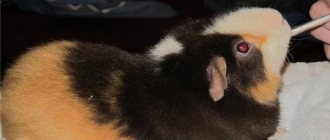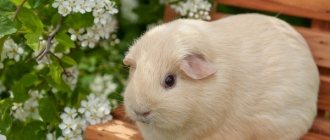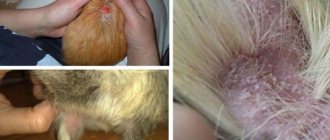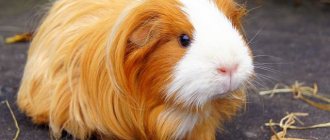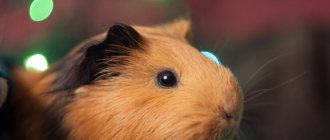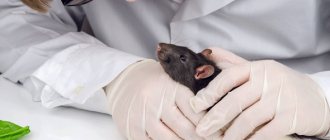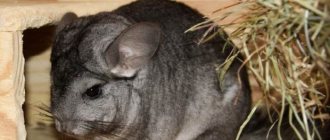With proper care, a guinea pig's lifespan can reach 10 years. When getting one, you need to be prepared that the animal can deliver not only positive emotions, but also become a cause of worry if the pet suddenly gets sick. If the pathology is not diagnosed and treated in time, it can cause the death of the rodent. Therefore, you should carefully monitor your pet’s behavior, the condition of its fur, anus, organs of hearing and vision, and also know what diseases guinea pigs have in order to help it if necessary.
Diseases of guinea pigs can be infectious, parasitic or non-infectious.
Infections
Guinea pigs can become infected with fungal, viral, and bacterial infections, such as:
- Plague is a dangerous disease of viral etiology. It is highly contagious and often ends in the death of the rodent. Once initiated, the latency period in most animals is typically a maximum of 21 days. After which symptoms of the disease are observed. The animal becomes lethargic, indifferent to what is happening. He may experience seizures, problems with coordination, and paralysis of his hind legs. Unfortunately, there is no cure for this disease and, if the diagnosis is confirmed, the infected scree is euthanized.
- Pseudotuberculosis is an infectious disease of a bacterial nature that is often diagnosed in guinea pigs. Infection is possible through contaminated food.
The infection often results in the death of the pet, as it occurs at lightning speed. Therefore, it is important to know the symptoms of the disease in order to begin treatment in a timely manner. The main symptom of infection is stomach upset. Mucus and blood can be found in the stool. In addition, the owner may notice loss of appetite in the animal, inflammation of the conjunctiva, enlargement of the mesenteric lymph nodes, and convulsions. What to do when it appears? It is necessary to show the rodent to a veterinarian as soon as possible. If the diagnosis is confirmed, then antibiotics and sulfonamides are prescribed. Tetracycline can be prescribed for treatment in loading dosage.
- Paratyphoid fever is an intestinal infection caused by bacteria and accompanied by signs of gastrointestinal damage, such as persistent diarrhea and bloating. The pig's stool is greenish and has an unpleasant odor. The animal refuses to eat, moves little, and is disheveled. If infection is confirmed, tetracycline and sulfadimizine are prescribed, and anti-typhoid serum is administered. In addition, to reduce the likelihood of re-infection, you should clean up after the rodent more often. Your pet's diet should consist of foods that are quickly digestible. The animal must have constant access to water.
- Pasteurellosis is a bacterial zoonotic disease that is dangerous to humans. If a guinea pig is sick, it will experience symptoms of respiratory damage: purulent nasal discharge, sneezing, shortness of breath, wheezing. As the infection progresses, indigestion, pustules, redness of the skin, and convulsions occur. The disease often causes the death of a rodent. Young individuals die especially often. If the infection is severe, the animal is destroyed. Treat a sick rodent with antibiotics. When pets have multiple antibiotics, antibiotic therapy is prescribed for all pets, regardless of whether they have symptoms of infection or not. Medicines are given within 7 days from the moment the disease is detected. It is also important to disinfect the room where the rodent is kept.
- Lymphocytic choriomeningitis is a dangerous viral disease not only for the animal, but also for its owners, which usually ends in the death of the pet. An infected individual exhibits elevated temperature and asthenia. The disease is incurable, so the infected individual is destroyed.
- Bordetellosis is a disease that affects not only guinea pigs, but also cats, dogs and other rodents. The main measure to prevent infection is vaccination of cats and dogs. There is also a vaccination against bordetellosis for guinea pigs, but, unfortunately, it is ineffective and only alleviates the course of the disease.
An infected pig may sneeze and have difficulty breathing. She may have a fever, nasal discharge, conjunctivitis, ear inflammation, loss of appetite, and impotence. Often, with such an infection, the pet's head is turned to the side. When a disease is detected, the pet must be treated comprehensively; the animal is prescribed antibiotics and sulfonamides.
Prescribe either Baytril (s.c.) at a dose of 5 mg per kg of body weight for 5 days or gentamicin (i.m.) at a dose of 4-5 mg per kg of body weight. In addition, sulfadimethoxine (25 mg/kg) or sulfatone (15 mg/kg) is given with food. The course of therapy is 5 days. Expectorants are also prescribed and added to the food. You can give your animal cough tablets with thermopsis or pectusin. To normalize breathing, prescribe sulfocamphocaine or caffeine in ampoules. Atropine is prescribed to relieve spasms. For a speedy recovery, it is recommended to give the animal multivitamins.
Sleep disturbance and hiccups
Guinea pigs are very active animals. They sleep several times a day and little by little, and in case of danger or in an alarming situation, the guinea pig sleeps with its eyes open. Young animals spend less time sleeping, but older animals spend much more time sleeping. If your guinea pig lives alone, it may also sleep longer. Sleep disturbances are usually caused by a nervous state, problems with skin parasites and improper feeding. You can identify problems with sleep in an animal by changing behavior - the guinea pig becomes more active, loses appetite, may show aggression and refuse offered treats. It is not the effect that should be treated, but the cause - examine the animal, donate blood for analysis and scrape the skin to identify skin parasites.
Sleep problems sometimes cause your guinea pig to hiccup.
Another cause of hiccups is a cold. Signs of a cold include lethargy, decreased appetite, elevated body temperature and heavy breathing. Purulent and mucous discharge is possible from the eyes and nose. Colds are treated with Sulfazine or Sulfadimezine 0.1 mg per kilogram of guinea pig weight three times a day.
Allergies also cause hiccups. Allergies are most often caused by dust contained in sawdust or hay, or too sweet or sour foods. In addition to allergies, problems with clean drinking water can also cause hiccups. The daily amount of water consumed by a pig is approximately 100 ml. However, if yesterday a guinea pig drank more than normal, and today it hardly comes to the drinking bowl, this is not a sign of concern. Sometimes the difference in water consumption can be explained by changes in weather and temperature, changes in mood and the abundance of succulent food in the feeder. But if the animal is thirsty and the drinking bowl is empty, then hiccups may occur.
Parasitic diseases
Parasitic diseases in guinea pigs are often diagnosed. They can be caused by internal and external parasites. The most commonly observed diseases are lice, lice and fleas in guinea pigs, as well as coccidiosis. Other infestations are rarely diagnosed and are discovered during an autopsy of the animal.
Guinea pigs have the following parasitic diseases:
- Fascioliasis is caused by flatworms. They attack the rodent's liver. Are there any occurrences of the disease? At an early stage, the invasion is asymptomatic. At a late stage, the animal refuses to eat and drink, is indifferent to everything, and it is no longer possible to help the pet. The disease is detected posthumously. Therefore, it is worth regularly deworming your pet and giving it only high-quality food and drink. Also, to reduce the risk of infection, you should not collect grass for the rodent in the morning, this is due to the developmental characteristics of the parasite.
- Young animals are more likely to suffer from coccidiosis, since adults develop immunity to the causative agents of the disease. Infection occurs with food. The fact that an animal is infected may be indicated by the appearance of loose stools with mucus and blood, matted fur near the anus, tympany, refusal to eat, and weakness. Even if symptoms occur in one animal, medications should be given to the entire livestock. Furazolone is prescribed at a dosage of 0.03 g per kg of weight. The duration of therapy can vary from 7 to 10 days. The medicine is added to the water; if the animal refuses to drink it, then succulent food is not given for a while or the medicine is mixed into the food.
- Trichomoniasis has a similar clinical picture to coccidiosis. The causative agent is Trichomonas gallinae. The main distinguishing sign of the disease is the deposition of yellow plaque in the mouth, which can cause breathing and eating problems. The animal must be helped as quickly as possible, otherwise it will die from suffocation. Metronidazole-based medications are prescribed at a dosage of 0.05 g per kg of weight.
- Oxyurosis is caused by roundworms. The infection is asymptomatic. Young and old animals may experience emaciation and loose stools with traces of blood. To prevent your pet from becoming infected, you need to deworm your pet at least once every six months. The first time you need to give anthelmintics is when the rodent is 2 months old.
- External parasites. Guinea pigs commonly have fleas, which results in hair loss, itching, and redness of the skin. Lice, ticks and lice are rare in pets. As a rule, they are found in nurseries where there are many animals. Domestic pigs can become infected from cats or dogs. To ensure that no fleas or other external parasites bother your pet, it should be bathed using antiparasitic shampoos. It is important that the animal’s diet is varied and that the cage is constantly cleaned using antiseptics.
Causes
The causative agent of pododermatitis is Staphylococcus aureus, which enters the animal’s body through damaged skin. The infection then spreads throughout the body, causing sepsis. Which leads to disappointing consequences.
The occurrence of wounds and microcracks in the skin of rodents can be caused by:
- Careless or infrequent cleaning of the pet's cage;
- lack of sufficient mobility of the pet in and outside the cage;
- lack of sufficient mobility due to problems with the pet’s excess weight;
- overgrown claws;
- reduced immunity;
- mechanical injury;
- baldness;
- lack of vitamin C;
- wet bedding, which softens the skin and becomes more susceptible to damage;
- hard bedding that can injure the skin.
Non-communicable diseases
Guinea pigs have the following non-contagious diseases:
- Cystitis or inflammation of the bladder in a pet can be manifested by restlessness and frequent but unsuccessful attempts to empty the bladder. Hematuria may be observed. To cure a pet, sulfonamides, antibiotics and antispasmodics are prescribed. If after a day the therapy does not produce results, an ultrasound or x-ray is prescribed to rule out kidney stones.
- Ovarian cysts, as a rule, are asymptomatic and are detected only at autopsy. Some pets may experience hair loss on both sides. The disease can be detected using ultrasound. In this case, it is advisable to remove the cyst along with the ovaries and uterus. Drug therapy is ineffective.
- Injuries. The pet may be injured by the cage. Also, if several animals are kept, they can injure each other. If your pet has a wound, then the hair around it should be cut and the damaged surface should be treated with 3% peroxide.
If there is a foreign body in the wound, it is removed and the pathology site is treated with an antibiotic ointment, for example, levomekol, and a sterile bandage is applied on top. Dressings are done every day. On the 4th day, the wound is treated with streptocide powder. The bandage is no longer applied. At the same time, it is advisable to give Bicilin 5 injections.
- Abscesses on the pads appear if the pet is kept outside the cage or on a slatted floor. The mechanism of occurrence of the pathology is still unclear. There is an assumption that due to the hard surface, the guinea pig cannot stand on his entire foot due to the claws. If your pet has abscesses on his pillows, his gait becomes unsteady. The animal lies down more and does not allow you to touch its paws. In addition to abscesses on the pads, you can sometimes notice corns. In order for your pet to recover, you need to pour a thick layer of bedding. It must be changed constantly. Damaged paws are treated with an antiseptic, lubricated with zinc ointment and wrapped with a bandage.
- Alopecia or pathological hair loss in a pet can be caused by stress or a lack of hay in the diet. To eliminate pathology, you need to introduce fresh and dry grass into the menu and eliminate the source of stress. Other causes of baldness are ringworm, psoroptic mange, and sarcoptic mange. Can these diseases be dangerous for humans? Yes, therefore, if foci of alopecia appear, you should not select medications to treat mumps on your own.
- Vitamin deficiencies and rickets develop due to a poor diet, lack of UV rays from the sun, or impaired absorption of vitamins due to inflammation of the small intestine. When rickets develops, the pet may eat its bedding, feces, or chew on its cage, which causes an upset stomach. But, as a rule, symptoms of the disease appear at a late stage, when changes in the musculoskeletal system become noticeable. With rickets, the pet experiences thickening of the joints, curvature of the paws, kyphosis, and retardation in physical development. In addition, with pathology, convulsions and paralysis may develop.
With vitamin deficiency, the clinical picture is the same. But delamination of the claws, corns, and disappearance of the shine of the coat are also observed. To eliminate the symptoms of vitamin deficiency, it is worthwhile to diversify your diet. The pet should be given raw vegetables and fruits, dry grass.
Rickets
This disease is formed when the working pace of the secretion glands is disrupted, as well as in the absence of the required amount of mineral salts in the animal’s body.
Pigs can get rickets in the winter . It is observed in young individuals.
Symptoms:
- curvature of limbs;
- thickening of joints;
- The pig's back sags.
Pigs suffering from rickets experience stunted growth.
Treatment
and 2-3 drops of trivitamin are added to the pig’s drinking water every day .
For treatment, the use of a quartz lamp is recommended . Radiation of a rodent can be carried out after receiving a recommendation from a veterinarian.
Eye diseases
Eye diseases develop for various reasons.
A guinea pig's eye becomes suppurated, usually due to conjunctivitis; it can be caused by mechanical damage, bacteria, viruses, fungi and parasites.
The disease is characterized by the following clinical manifestations:
- eyes fester and water;
- photophobia;
- due to pus, the eyelids stick together;
- clouding of the cornea, pupils do not respond to light.
It is better to ask your veterinarian what to do if the disease develops. He will tell you what medications can be used if pathology appears. Since viral and bacterial conjunctivitis are treated differently.
Less commonly, guinea pigs are diagnosed with keratitis, which appears as a result of corneal injuries. As a rule, pathology is detected when the pet has clouding of the cornea. For treatment, antibacterial medications are prescribed in the form of drops and ointments, which must be applied every 2 hours.
Abscess in guinea pigs
The abscess most often appears on the back, sides and tummy, and takes the form of a hard lump covered with hair and can reach two or more centimeters in size. When pressing, you can feel the liquid, but the animal does not show any signs of pain or anxiety. An abscess is a capsule filled with pus. Pus may break out if the capsule is completely ripe. The opened wound must be washed with hydrogen peroxide and thoroughly cleaned of pus. Most often, the wound heals the very next day. The cause of an abscess can be a bruise or an injection from a sharp twig, or a fight with another guinea pig. To speed up the maturation of the abscess, it is good to make lotions with Vishnevsky ointment or ichthyol ointment, and also increase foods containing vitamin C in the diet.
Otitis
When the ears become inflamed, guinea pigs may experience excessive excitability. The animal becomes aggressive, its head tilted to the side. When the pathological process of a bilateral pet lowers its head down, circular movements are often observed, while the pig itches and shakes its head. The animal refuses to eat and loses weight. Purulent otitis is accompanied by purulent discharge from the ears.
When the disease develops, local medications are prescribed. First, the rodent's ears are treated with an antiseptic to remove blood and pus that have dried in them. Then antimicrobial and anti-inflammatory drops are instilled, for example, Surolan. Therapy is continued until the symptoms of the disease disappear.
It is necessary to differentiate ear inflammation from torticollis, a neurological disease that cannot be treated.
Causes
Pododermatitis is not a contagious disease and is not included in the list of hereditary diseases. External factors that contribute to the development of pododermatitis are:
- Weak rodent activity. A cramped cage, inaccessibility to walks and lack of ability to move provoke the onset of the disease.
- Obesity. Improper nutrition causes physical inactivity and increases the load on the paws and skeleton.
- Cover in the enclosure. The smooth surface, in contact with the animal’s paws, interferes with the natural grinding of the claws. Overgrown claws change the angle of the paw and add additional stress to the joint.
- Aging of the rodent and age-related tendency to develop the disease.
- Injury. A damaged surface of the pallet or dangerous objects in the enclosure can cripple a limb.
- Small edge on the inside of the paws.
- Inflammation of the skin caused by parasites or allergies.
- Inconsistent and careless cleaning of the cage. Rotten food and animal feces mixed with sawdust come into contact with the skin and cause bacteria.
- Lack of vitamin C in the pet's body.
Daily examination of the pet, timely cleaning of the enclosure and balanced food will prevent the development of the disease.
Tumors
Neoplasms are usually diagnosed in adults. Generally, guinea pigs suffer from breast and skin cancer. In most cases, breast tumors are operable and the prognosis is favorable.
Skin cancers may appear as a lump on the back and can be removed surgically. With this course, metastases are not observed. The development of skin cancer may also be indicated by the appearance of spots on the hind legs. In this case, the prognosis is less favorable.
There are a variety of diseases observed in guinea pigs, and it is quite difficult to diagnose them at home. Therefore, if your pet has health problems, you should contact a specialist who will tell you what to do.
Seizures in guinea pigs
Paralysis is a dangerous and serious disease that can be caused by both infections and injuries. The first symptoms of paralysis are refusal to eat, severe fever, and apathy. The guinea pig is breathing very heavily, trembling and lying on his side. The disease is often accompanied by convulsions and limb failure. If the breeder notices dangerous symptoms in an animal, it should be immediately separated from the other animals and shown to a veterinarian to establish an accurate diagnosis.
Convulsions can be caused not only by paralysis, but also by a more dangerous disease - pestilence.
If a guinea pig's cage was exposed to direct sunlight for a long time, the animal could overheat and suffer heatstroke. In this case, seizures are one of the most important and first symptoms. The cage with the animal must be moved to a cool place and the animal must be provided with sufficient water. You can also cover your guinea pig with a damp, cold towel for a short time. In more rare cases, seizures may accompany heart and lung problems.
Prevention
As a rule, to avoid your pet getting sick, you need to periodically apply preventive actions:
- Maintain cleanliness in the enclosure, change the bedding daily, monitor the hardness of the sawdust and the thickness of the filler layer.
- A varied and enhanced diet is required with the addition of foods rich in vitamin C and supporting the rodent’s immunity.
- Monitor the weight of the rodent and carry out timely hygiene procedures.
- Take time to play with your pet, increasing physical activity.
At the initial stage, pododermatitis seems to be an innocent disease, and only over time do insidious symptoms appear that can lead to the death of the animal. Self-prescription of drugs and treatment without the supervision of a specialist is unacceptable . Fortunately, effective treatment, care and patience from the owner can cure the most severe cases of the disease.
